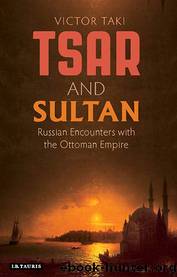Tsar and Sultan by Taki Victor;

Author:Taki, Victor;
Language: eng
Format: epub
Tags: History 1700–1900, Diplomacy, Battles and Campaigns, Military history, Middle East history, Crimean war, Social and cultural history, Islamic studies, Colonialism and Imperialism, Economic history, Ottoman Empire, Russia
ISBN: 4890527
Publisher: I. B. Tauris & Company, Limited
CHAPTER 5
PEOPLES OF EMPIRE
The question of the GrecoâSlavic peoples constitutes the central aspect of the Eastern Question.1
A Russian description of the Ottoman Empire published in 1829 claimed that Turks constituted the majority of the population of the European domains of the sultan, followed by Greeks and Armenians.2 Accordingly, the better part of the book was devoted to a description of the history of Islam, the rise of the Ottomans and their political system, their army, the national character of the Turks and their principal occupations, their capital city of Constantinople with its environs as well as the most important provincial cities of the empire. The book also provided a rather detailed discussion of continental and insular Greece, which followed the same pattern, as well as addressed at some length the state of the Ottoman vassal principalities of Moldavia and Wallachia. By contrast, the Serbian and Bulgarian subjects of the Porte were given slightly more than a page each.
The author's apparent ignorance of the actual ethnic composition of âTurkey in Europeâ is all the more remarkable in view of the fact that by 1829 Russia was in its sixth war against the Ottoman Empire in little over a century. To be sure, in terms of the information on the sultan's Christian subjects, the 1829 review was much better than the one published ninety years previously, in which the author did not even mention the term reaya and focused exclusively on the Ottomans and their Muslim vassals, such as the Egyptian and Tripolitan beys and the Crimean Tatars.3 Nevertheless, in the early nineteenth century, Russian knowledge about the Orthodox population of the Ottoman Empire was still very uneven. This becomes clear as soon as one compares the 1829 book with the one published in 1854, which contained equal chapters on all the major provinces and peoples of âTurkey in Europeâ.4
This chapter argues that this unevenness reflected a sequence of Russian âdiscoveriesâ of the subject peoples of the Ottoman Empire. Each of the consecutive RussianâOttoman wars of the late eighteenth â first half of the nineteenth century brought a particular Balkan people to the attention of the educated Russians, many of whom served in the active army. Every discovery of this kind implied not only an interest of the Russian public in the national character of a given people, but also a growing attention to the nature of its relations with the Ottomans and other subject peoples of the sultan. As a result of these discoveries, by the time of the Crimean War, the Russians had acquired a fuller understanding of the complex ethnic mosaic of the European provinces of the Ottoman Empire. The appreciation of this ethnic complexity was an important step towards the transformation of Russian representations of the âTurkey in Europeâ into a version of the discourse of Balkanism, which defined the peoples of the region in their own right, increasingly apart from their weakening dependence upon the Ottoman overlords.5
Whereas historians have so far focused on RussianâGreek, RussianâSerbian or RussianâBulgarian
Download
This site does not store any files on its server. We only index and link to content provided by other sites. Please contact the content providers to delete copyright contents if any and email us, we'll remove relevant links or contents immediately.
| Africa | Americas |
| Arctic & Antarctica | Asia |
| Australia & Oceania | Europe |
| Middle East | Russia |
| United States | World |
| Ancient Civilizations | Military |
| Historical Study & Educational Resources |
Magic and Divination in Early Islam by Emilie Savage-Smith;(1498)
Ambition and Desire: The Dangerous Life of Josephine Bonaparte by Kate Williams(1343)
Bohemians, Bootleggers, Flappers, and Swells: The Best of Early Vanity Fair by Bohemians Bootleggers Flappers & Swells- The Best of Early Vanity Fair (epub)(1341)
Papillon by Henry Charrière(1307)
Twelve Caesars by Mary Beard(1254)
Operation Vengeance: The Astonishing Aerial Ambush That Changed World War II by Dan Hampton(1134)
What Really Happened: The Death of Hitler by Robert J. Hutchinson(1127)
London in the Twentieth Century by Jerry White(1111)
Time of the Magicians by Wolfram Eilenberger(1086)
The Japanese by Christopher Harding(1084)
Twilight of the Gods by Ian W. Toll(1083)
Lenin: A Biography by Robert Service(1042)
The Devil You Know by Charles M. Blow(984)
A Social History of the Media by Peter Burke & Peter Burke(936)
Freemasons for Dummies by Hodapp Christopher;(921)
Napolean Hill Collection by Napoleon Hill(902)
Henry III by David Carpenter;(890)
The Churchill Complex by Ian Buruma(879)
The Rise and Triumph of the Modern Self by Unknown(877)
